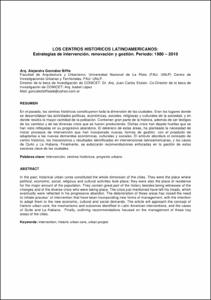Mostra el registre d'ítem simple
Los centros históricos latinoamericanos: estrategias de intervención, renovación y gestión. Periodo: 1980-2010
| dc.contributor.author | González Biffis, Alejandra |
| dc.date.accessioned | 2014-04-08T18:33:48Z |
| dc.date.available | 2014-04-08T18:33:48Z |
| dc.date.issued | 2013-06 |
| dc.identifier.citation | González Biffis, Alejandra. Los centros históricos latinoamericanos: estrategias de intervención, renovación y gestión. Periodo: 1980-2010. A: Seminario Internacional de Investigación en Urbanismo. "V Seminario Internacional de Investigación en Urbanismo, Barcelona-Buenos Aires, junio 2013". Barcelona: DUOT, 2013, p. 636-648. |
| dc.identifier.issn | 2339-6598 |
| dc.identifier.uri | http://hdl.handle.net/2099/14475 |
| dc.description.abstract | En el pasado, los centros históricos constituyeron toda la dimensión de las ciudades. Eran los lugares donde se desarrollaban las actividades políticas, económicas, sociales, religiosas y culturales de la sociedad, y en donde residía la mayor cantidad de la población. Contienen gran parte de la historia, además de ser testigos de los cambios y de las diversas crisis que se fueron produciendo. Dichas crisis han dejado huellas que se han visto reflejadas en su progresivo abandono. El deterioro de estas áreas, ha planteado la necesidad de iniciar procesos de intervención que han incorporado nuevas formas de gestión, con el propósito de adaptarlas a las nuevas demandas económicas, culturales y sociales. El artículo abordará el concepto de centro histórico, los mecanismos y resultados identificados en intervenciones latinoamericanas, y los casos de Quito y La Habana. Finalmente, se esbozarán recomendaciones enfocadas en la gestión de estos sectores clave de las ciudades. |
| dc.description.abstract | In the past, historical urban cores constituted the whole dimension of the cities. They were the place where political, economic, social, religious and cultural activities took place; they were also the place of residence for the major amount of the population. They contain great part of the history besides being witnesses of the changes and of the diverse crisis who were taking place. The crisis just mentioned have left his treads, which eventually were reflected in his progressive abandon. The deterioration of these areas has raised the need to initiate process´ of intervention that have been incorporating new forms of management, with the intention to adapt them to the new economic, cultural and social demands. The article will approach the concept of historic urban core, the mechanisms and outcomes identified in Latin American interventions, and the cases of Quito and La Habana. Finally, outlining recommendations focused on the management of these key areas of the cities. |
| dc.format.extent | 13 p. |
| dc.language.iso | spa |
| dc.publisher | Departament d'Urbanisme i Ordenació del Territori. Universitat Politècnica de Catalunya |
| dc.publisher | Instituto del Conourbano. Universidad Nacional General Sarmiento |
| dc.publisher | Instituto de Arte Americano. Universidad de Buenos Aires |
| dc.relation.ispartof | Seminario Internacional de Investigación en Urbanismo (5è: 2013: Barcelona, Buenos Aires) |
| dc.rights | Attribution-NonCommercial-NoDerivs 3.0 Spain |
| dc.rights.uri | http://creativecommons.org/licenses/by-nc-nd/3.0/es/ |
| dc.subject | Àrees temàtiques de la UPC::Urbanisme::Projecte urbà |
| dc.subject.lcsh | Urban renewal -- Latin America |
| dc.subject.lcsh | Historic districts -- Latin America |
| dc.subject.other | Intervención |
| dc.subject.other | Centros históricos |
| dc.subject.other | Proyecto urbano |
| dc.subject.other | Intervention |
| dc.subject.other | Historic urban core |
| dc.subject.other | Urban project |
| dc.title | Los centros históricos latinoamericanos: estrategias de intervención, renovación y gestión. Periodo: 1980-2010 |
| dc.type | Conference report |
| dc.subject.lemac | Rehabilitació urbana -- Amèrica Llatina |
| dc.subject.lemac | Centres històrics -- Amèrica Llatina |
| dc.identifier.doi | 10.5821/siiu.5869 |
| dc.identifier.dl | B-15.590-2013 |
| dc.description.peerreviewed | Peer Reviewed |
| dc.rights.access | Open Access |
| local.citation.author | González Biffis, Alejandra |
| local.citation.contributor | Seminario Internacional de Investigación en Urbanismo |
| local.citation.pubplace | Barcelona |
| local.citation.publicationName | V Seminario Internacional de Investigación en Urbanismo, Barcelona-Buenos Aires, junio 2013 |
| local.citation.startingPage | 636 |
| local.citation.endingPage | 648 |
| local.ordre | 45 |


